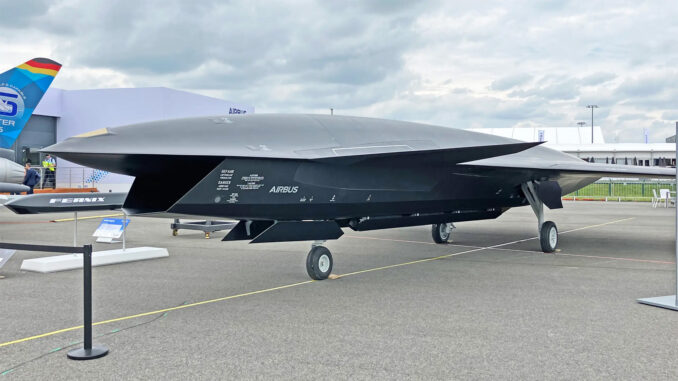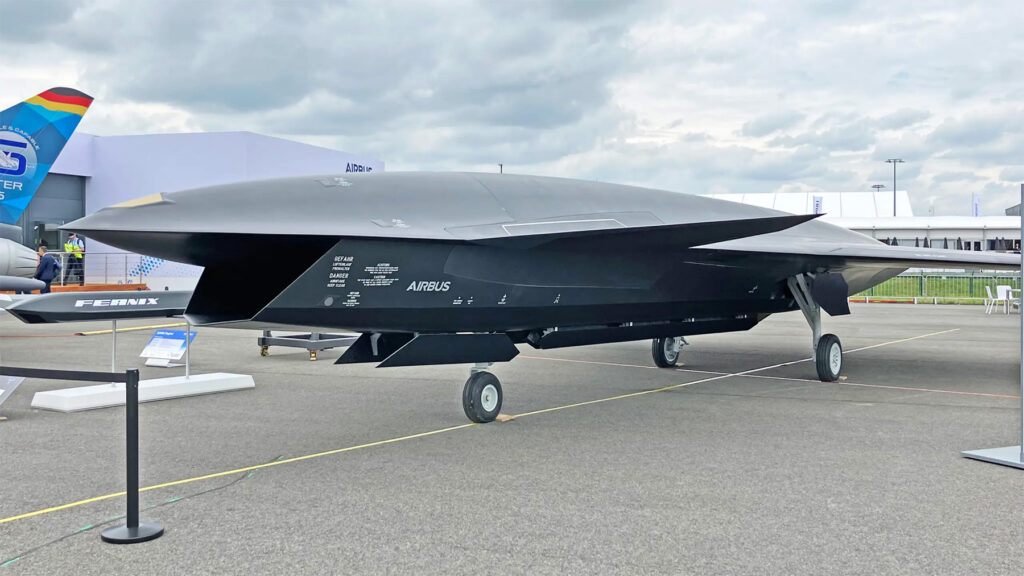
Airbus unveils the Wingman, a low-cost stealth drone designed to enhance military capabilities. Full analysis of specifications and implications.
In brief
Airbus has unveiled its Wingman stealth drone, an unmanned aircraft designed to enter service in the 2030s. The Wingman will cost around a third of the price of a manned fighter aircraft and will be designed to operate in conjunction with manned fighters. It will be equipped with advanced technologies, including artificial intelligence (AI), to facilitate its management and autonomous operations. This UAV represents a response to the Luftwaffe’s needs in terms of unmanned support and will be integrated into the European FCAS programme.
Presentation of the Airbus Wingman UAV
The Airbus Wingman UAV, recently unveiled at the ILA Berlin aerospace show, is an unmanned stealth aircraft concept designed to complement traditional fighter aircraft. With a wingspan of 11.9 metres and a length of 15.5 metres, the Wingman is designed to enter service in the 2030s and cost around a third of the price of a manned fighter aircraft. The aim is to provide effective support while reducing costs.
Technical characteristics of the Wingman
The Wingman has a stealthy design and is equipped to carry out a range of missions, from reconnaissance to ground attack. Its design includes two internal bays for carrying weapons, optimising its radar stealth. The drone will be powered by the Eurojet EJ200 engine, the same as that used by the Eurofighter, guaranteeing simplified reliability and maintenance thanks to this standardisation.
Advantages of using the Wingman
Reduced operational costs
One of the main advantages of the Wingman is its reduced cost. At around a third of the cost of a manned fighter aircraft, this drone makes it possible to maintain air power while reducing expenditure. This cost reduction means that armed forces can deploy more aircraft, increasing their operational flexibility.
Versatility and modularity
The Wingman’s modular design means it can be adapted to different mission configurations. For example, it can be fitted with external pylons to carry additional weapons such as Paveway precision bombs and Brimstone air-to-ground missiles. This versatility is crucial in responding to a variety of combat scenarios.

Potential drawbacks and challenges
Technological complexity and AI
The integration of advanced technologies, such as AI for autonomous control, represents a significant challenge. Although these technologies can improve operational efficiency, they require rigorous development and sophisticated maintenance. In addition, reliance on AI raises questions about the reliability and safety of operations in the event of technical malfunctions.
Logistical implications
Bringing Wingman into service involves major logistical challenges. Training operators, maintaining systems and integrating with existing infrastructures will require considerable resources. The armed forces must also adapt their strategies and doctrines to integrate these new aircraft effectively into their operations.
Consequences of Wingman integration
Impact on military capabilities
The addition of the Wingman to the armed forces could transform military capabilities, providing increased support and reducing risk to pilots. Working alongside the Eurofighter and F-35A, the Wingman will increase the resilience and flexibility of air operations, enabling a faster and more effective response to threats.
Strategic implications
The introduction of the Wingman could influence military strategies on a global scale. Other nations could be encouraged to develop similar systems so as not to be at a technological disadvantage. This technological arms race could alter power dynamics and military alliances.
Future development and prospects
The Wingman project is currently funded by Airbus, with significant investments already made. Airbus hopes that the Luftwaffe will demonstrate its interest by signing a contract for the UAV. Current conflicts on Europe’s borders underline the importance of air superiority, and Wingman could play a key role in meeting this growing requirement.
The Wingman represents a major advance in the field of military UAVs, combining cutting-edge technologies with reduced operational costs. Its integration into the armed forces could transform air operations and influence global military strategies. However, technological and logistical challenges need to be overcome to realise its full potential.
War Wings Daily is an independant magazine.